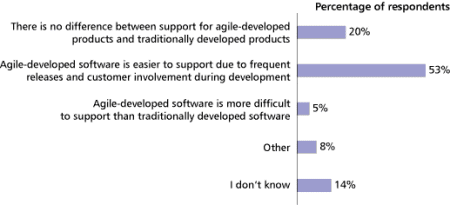A recent Cutter Consortium survey explored the effect of agile methods on software maintenance. In virtually all product-support categories, agile-developed software products were generally easier to maintain and customer satisfaction was generally higher (compared to traditional development methods). The objective of the survey, developed and analyzed by Cutter Consortium Senior Consultant E.M. Bennatan, was to understand the advantages (or disadvantages) of agile methods after the release of a software product.
An impressive majority of software development organizations (77%) report that they have adopted agile methods, at least for some of their projects. And according to the data (see Figure 1), most of these organizations (53%) found that agile-developed software is easier to support due to frequent product releases and customer involvement during development.

Figure 1 -- How does agile development (evolutionary, short-cycled, customer-driven) affect your organization's ability to provide software product support?
Bennatan delved deeper into the data to discern how the support activities differ in those organizations that reported agile-developed software having either a positive or negative impact on support activities.
"What I found was that a significant number of organizations (46%) reported that customer involvement during agile development leads to higher customer satisfaction, which in turn leads to better interaction with customers and users. No companies disagreed, that is, none found that customer involvement hindered product support.
"Interestingly, about a third (34%) reported that agile-developed products are usually released with fewer defects, thus reducing the need for software maintenance, while only 3% found more defects, which increased the need for maintenance."
26% of surveyed companies reported that products with frequent releases and more customer involvement require fewer support resources (staff, budget, etc.). But this finding was less clear-cut, and 10% disagreed (they found that agile-developed products require more resources). Yet another controversial finding was reported by 16%: they found less of a need for customer-specific changes due to frequent product releases, while 8% reported the opposite (their agile projects needed more changes).
Says Bennatan, "The general conclusion from these findings is that agile-developed software products are usually, but not always, easier to support. The divergence of views is likely driven by the characteristics of the products developed, of the development organization (especially its level of agile expertise), and of the customer/user base -- all of which affect the benefits that agile can provide during the support phase. All the same, the fact that agile-developed software products are usually easier to support should encourage organizations to consider the adoption of agile when feasible."
Demographics: The Cutter survey, which included more than 100 software development organizations, studied how companies deal with maintenance and other software support issues. The survey covered a broad range of organizations: 45% have fewer than 25 developers, 23% have between 25 and 100, and 32% have more than 100 developers (of those, 18% have more than 400). The survey also covered a fair mix of both small and larger projects: at 59% of surveyed companies, projects are typically small -- fewer than 5 person-years; at 35%, they are between 5 and 20 person-years (of those, at 11%, they are between 11 and 20), while the remaining 6% typically have larger projects that are more than 20 person-years (of those, at 4%, they are more than 40).
To schedule an interview with E.M. Bennatan, contact Anne Mullaney (+1 781 641 5101 or amullaney@cutter.com) or Kim Leonard (+1 781 641 5111 or kleonard@cutter.com. For biographical information, visit www.cutter.com/meet-our-experts/bennatane.html


